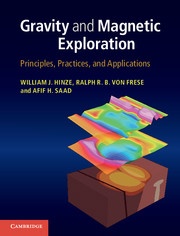Book contents
- Frontmatter
- Dedication
- Contents
- Preface
- Acknowledgements
- 1 Introduction
- Part I Gravity exploration
- 2 The gravity method
- 3 Gravity potential theory
- 4 Density of Earth materials
- 5 Gravity data acquisition
- 6 Gravity data processing
- 7 Gravity anomaly interpretation
- Part II Magnetic exploration
- Part III Applications
- Appendix A Data systems processing
- References
- Index
5 - Gravity data acquisition
from Part I - Gravity exploration
Published online by Cambridge University Press: 05 May 2013
- Frontmatter
- Dedication
- Contents
- Preface
- Acknowledgements
- 1 Introduction
- Part I Gravity exploration
- 2 The gravity method
- 3 Gravity potential theory
- 4 Density of Earth materials
- 5 Gravity data acquisition
- 6 Gravity data processing
- 7 Gravity anomaly interpretation
- Part II Magnetic exploration
- Part III Applications
- Appendix A Data systems processing
- References
- Index
Summary
Overview
Although simple in principle, the measurement of gravity for geologic purposes to an accuracy of the order of 10-8 to 10-9 of the Earth's gravitational field requires highly sophisticated instrumentation and rigorous survey procedures. Fundamentally because of the nature of the measurement, all gravity instrumentation must be mechanical. Most land gravity measurements are made with relative-measuring instruments using the zero-length spring principle to achieve high sensitivity in portable instrumentation. Although extensive governmental and commercial databases containing millions of observations exist, additional gravity surveying continues to achieve greater detail and accuracy in the data. Random errors are minimized in modern instrumentation by performing the observations automatically. However, residual errors remain, owing both to inherent instrumentation problems and non-geologic acceleration components that need to be considered while conducting surveys.
Increasingly accurate observations and improved anomaly resolution are being achieved especially in marine and airborne observations of gravity. A variety of instrumentation is used for measurements on mobile platforms, including modified zero-length spring gravimeters and electromagnetic accelerometers mounted on gyrostabilized platforms to minimize short-period horizontal and vertical accelerations due to movements of the ship or aircraft. In addition, highly accurate absolute gravity measurements are being made with stable, portable free-fall instruments, and rotating-disk gravity gradiometers are being used to observe the gravitational tensor components. These improvements are useful not only in mapping components of the gravity field related to variations in subsurface geology, but also in monitoring time-variable processes within the Earth associated with mass changes.
- Type
- Chapter
- Information
- Gravity and Magnetic ExplorationPrinciples, Practices, and Applications, pp. 88 - 121Publisher: Cambridge University PressPrint publication year: 2013



